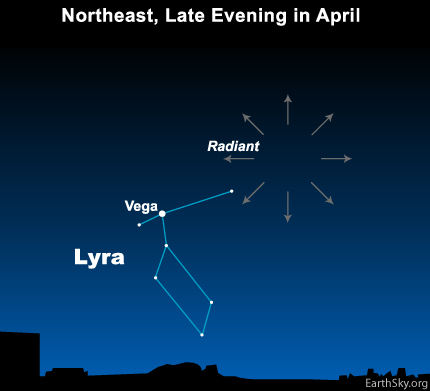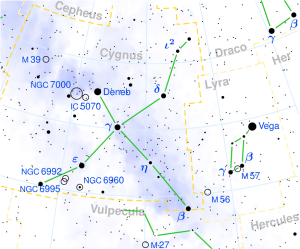The Lyrid meteor shower, also known as the April Lyrids, is one of the oldest known meteor showers, with records dating back more than 2,600 years.
The Lyrids are an annual event that peaks around April 22 and the early morning of April 23 each year. Lyrid meteors can typically be seen from April 16 to April 25. The parent body of the meteor shower is the comet C/1861 G1, also known as Comet Thatcher. When the meteor shower peaks, observers can usually see between 5 and 20 Lyrid meteors per hour. The average zenithal hourly rate is 10 meteors per hour.
More Lyrid meteors can be seen from rural areas than from cities, and the meteor shower puts on a bigger spectacle when it is not obscured by the light of the Moon. The best time to observe the Lyrids is in the hours just before dawn.
In 2015, the meteor shower is expected to produce 10 to 20 meteors per hour and the waxing crescent Moon will not obscure the view. There is a small, unlikely possibility that the Earth may pass through a sizable clump of the comet’s debris and that more meteors will be visible at the peak.

On the night of April 21, the 2012 Lyrid meteor shower peaked in the skies over Earth. While NASA allsky cameras were looking up at the night skies, astronaut Don Pettit aboard the International Space Station trained his video camera on Earth below. Image: NASA/JSC/D. Pettit
The Lyrids are typically around magnitude 2, but some of the brighter meteors, known as the Lyrid fireballs, have been known to briefly cast shadows before leaving behind trails of debris. The trails of the Lyrid fireballs can stay visible for minutes.

The radiant point of the Lyrid meteor shower is near the star Alpha Lyrae (proper name Vega), the brightest star in the constellation Lyra the Harp. At the time of the Lyrids’ peak each year (around April 22), you will find this radiant point in the northeast in late evening and higher in the sky as night passes. Although the meteors appear to radiate from a point in the sky near the bright star Vega, they are not truly associated with this distant star. Instead, meteors in annual showers like the Lyrids originate as relatively nearby bits of debris left behind in the orbits of comets. The comet associated with the Lyrids is periodic Comet C/1861 G1 Thatcher. Image: Bruce McClure and Joni Hall, EarthSky.org
Once every 60 years, the Lyrids intensify when the one-revolution dust trail, the comet’s dust trail that has completed one orbit, comes into Earth’s path, causing an Lyrid meteor outburst.
In 1922 and 1982, observers counted 90 meteors per hour at the peak. In 1803, the April Lyrids produced an even bigger meteor storm , with up to 700 meteors per hour visible on the date of the peak.
The radiant of the Lyrid meteor shower, the point in the sky from which the Lyrids appear to originate, lies in the direction of the small northern constellation Lyra.
Lyra can be located pretty easily as it contains Vega, the fifth brightest star in the sky and one of the stars that form the Summer Triangle. The radiant itself is located near Vega. The Lyrids, however, can be seen anywhere in the sky.
Facts
The Lyrids are the strongest annual meteor shower generated by a long-period comet. Comet Thatcher, or C/1861 G1, was named after the American amateur astronomer A. E. Thatcher, who discovered it on April 5, 1861.
The comet came within 50.1 million kilometres (31.1 million miles) from Earth in May 1861 and made its closest approach to the Sun (perihelion) in June 1861. The comet’s perihelion distance is 0.9207 astronomical units and its aphelion (greatest distance) is 110 astronomical units, when its orbit takes it beyond Eris.
Comet Thatcher has an orbital period of about 415 years and will next come to perihelion around the year 2276.
The first record of the Lyrid meteor show comes from China, where a Lyrid meteor storm was observed in 687 BC. Zuo Zhuan, one of the earliest and most important Chinese works of narrative history, mentions that “at night, fixed stars are invisible, at midnight, stars dropped down like rain.”
To the Boorong people in Australia, the Lyrid meteor shower represents the scratching of the mallefowl, a ground-dwelling Australian bird known for the large nesting mounds the male constructs. The April Lyrids coincide with the bird’s nesting season. The celestial mallefowl itself is represented by the bright star Vega.
Lyrid meteor shower
Parent body: C/1861 G1 (Comet Thatcher)
Radiant: Lyra constellation
First record of discovery: 687 BC
Dates: April 16 to 25
Peak: April 22
Zenithal hourly rate: 10 meteors per hour on average
